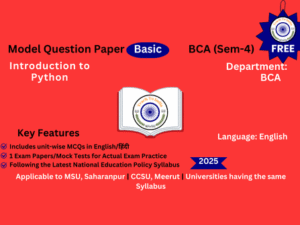Chemical Energetics and Radiochemistry - रासायनिक ऊर्जाविज्ञान एवं रेडियो रसायनिकी – Adv
- Description
- Curriculum
- Reviews

Model Question Paper
Chemical Energetics and Radiochemistry – रासायनिक ऊर्जाविज्ञान एवं रेडियो रसायनिकी
Key Features | मुख्य विशेषताएँ
-
Bilingual Model Paper | द्विभाषी मॉडल पेपर
This model paper is Designed in English and Hindi, making it easier for students from both mediums to understand and practice effectively.
यह मॉडल पेपर अंग्रेज़ी और हिंदी दोनों भाषाओं में डिज़ाइन किया गया, जिससे दोनों माध्यमों के छात्रों को अध्ययन और अभ्यास करने में आसानी हो। -
Unit-wise Short Notes | इकाईवार संक्षिप्त नोट्स
Each unit includes a summary in both languages, making revision faster and more effective.
प्रत्येक इकाई में दोनों भाषाओं में सारांश उपलब्ध है, जिससे पुनरावृत्ति तेज़ और प्रभावी हो सके। -
Extensive MCQ Practice | विस्तृत MCQ प्रैक्टिस
1500+ MCQ Practice Questions: This comprehensive question bank includes 1500+ multiple-choice questions (MCQs). Each unit contains approximately 150 MCQs covering a wide range of cognitive levels such as remembering, understanding, application, and analysis.
1500+ MCQ अभ्यास प्रश्न: इस प्रश्न बैंक में 1500 से अधिक बहुविकल्पीय प्रश्न (MCQ) शामिल हैं। प्रत्येक यूनिट में लगभग 150 MCQ हैं, जो याददाश्त, समझ, अनुप्रयोग और विश्लेषण जैसे विभिन्न संज्ञानात्मक स्तरों को कवर करते हैं। -
Exam Practice Paper with Mock Tests | मॉक टेस्ट के साथ परीक्षा अभ्यास पत्र
Includes three full-length mock tests for real exam practice.
तीन पूर्ण मॉक टेस्ट दिए गए हैं, जिससे छात्र वास्तविक परीक्षा अभ्यास कर सकें। -
Latest Syllabus as per NEP | NEP के अनुसार नवीनतम पाठ्यक्रम
The syllabus aligns with the latest National Education Policy (NEP) and follows the exam patterns of MSU, CCSU, and other universities following the NEP.
पाठ्यक्रम नवीनतम राष्ट्रीय शिक्षा नीति (NEP) के अनुसार है और यह MSU, CCSU तथा अन्य NEP का पालन करने वाले विश्वविद्यालयों की परीक्षा प्रणाली का अनुसरण करता है। -
Designed by Experts | विशेषज्ञों द्वारा तैयार किया गया
This question bank has been meticulously prepared by subject matter experts to ensure accuracy and relevance.
यह प्रश्न बैंक विषय विशेषज्ञों द्वारा सावधानीपूर्वक तैयार किया गया है, जिससे इसकी सटीकता और प्रासंगिकता बनी रहे।
Why Choose This Model Paper? | यह मॉडल पेपर क्यों चुनें?
-
Dual-Language Advantage: Ideal for both English and Hindi medium students.
द्विभाषी लाभ: अंग्रेज़ी और हिंदी दोनों माध्यमों के छात्रों के लिए उपयुक्त। -
Complete Exam Preparation: Unit-wise summaries, MCQ practice, and mock tests provide a complete study solution.
पूर्ण परीक्षा तैयारी: इकाईवार सारांश, MCQ अभ्यास, और मॉक टेस्ट संपूर्ण अध्ययन समाधान प्रदान करते हैं। -
Latest NEP-Based Pattern: Ensures compliance with the latest university exam structure.
नवीनतम NEP-आधारित पैटर्न: यह नवीनतम विश्वविद्यालय परीक्षा संरचना के अनुरूप है।
|
Program/Class: Degree/ Bachelor of Science |
Year: Third |
Semester: Sixth |
||
|
Subject: Chemistry |
||||
|
Course Title: Chemical Energetics and Radio Chemistry |
||||
|
Course Learning Outcomes Upon successful completion of this course students should be able to describe laws of thermodynamics and its applications, phase equilibria of one and two component system, electro chemistry ,ionic equilibrium applications of conductivity and potentiometric measurements |
||||
|
Credits: 4 |
Core Compulsory |
|||
|
Max. Marks: –25+75 |
Min. Passing Marks: 40 |
|||
|
Unit |
Topics |
|||
|
I |
Thermodynamics-1 : First Law of Thermodynamics : Statement , definition of internal energy and enthalpy. Heat capacity ,heat capacities at constant volume and pressure and their relationship. Joule’s law – Joule Thomson coefficient and inversion temperature . Calculation of w, q, dU & dH for the expansion of ideal gases under isothermal and adiabatic conditions for reversible process. Thermochemistry: Standard state, standard enthalpy of formation – Hess’s law of heat summation and its applications. Heat of reaction at constant pressure and at constant volume . Enthalpy of neutralization . Bond dissociation energy and its calculation from thermo-chemical data , temperature dependence of enthalpy. Kirchhoff’s equation
|
|||
|
II |
Thermodynamics II Second Law of Thermodynamics, Need for the law, different statements of the law, Carnot cycle and its efficiency. Carnot theorem. Thermodynamic scale of temperature. Concept of Entropy, Entropy as a state function, entropy as a function of V & T, entropy as a function of P & T, entropy change in physical change, Clausius inequality , entropy as a criteria of spontaneity and equilibrium. Entropy change in ideal gases and mixing of gases. Gibbs and Helmholtz Functions Gibbs function (G) and Helmhotz function (A) as thermodynamic quantities. A & G as criteria for thermodynamic equilibrium and spontaneity, their advantage over entropy change, Variation of G and A with P, V and T. Third Law of Thermodynamics ; Nernst heat theorem , statement and concept of residual entropy.Nernst distribution law – Thermodynamic derivation, applications . |
|||
|
III |
Electrochemistry: Electrical transport:- Conduction in metals and in electrolyte solutions, specific conductance molar and equivalent conductance, measurement of equivalent conductance, variation of molar, equivalent and specific conductances with dilution. Migration of ions and Kohlrausch law , Arrhenius theory of electrolyte dissociation and its limitations. Weak and strong electrolytes . Ostwald’s dilution law, its uses and limitations . Debye-Huckel-Onsager equation for strong electrolytes (elementary treatment only) . Transport number, definition and etermination by Hittorf method and moving boundary method.
|
|||
|
IV |
Ionic Equilibrium: Electrode reactions, Nernst equation, derivation of cell EMF and single electrode potential, standard hydrogen electrode-reference electrodes and their applications, standard electrode potential, sign conventions, Electrolytic and Galvanic cells–Reversible and irreversible cells, conventional representation of electrochemical cells. EMF of a cell and its measurement. Definition of pH and pKa , determination of pH using hydrogen, quinhydrone and glass electrodes by potentiometric methods. Buffers – Mechanism of buffer action, Henderson-Hazel equation, application of buffer solution. Hydrolysis of salts
|
|||
|
V |
Photo Chemistry: Interaction of radiation with matter, difference between thermal and photochemical processes . Laws of photochemistry: Grothus- Drapper law, Stark-Einstein law, Jablonski diagram depicting various processes occurring in the excited state, qualitative description of fluorescence, phosphorescence, non-radiative processes (internal conversion, intersystem crossing), quantum yield, photosensitized reactions – energy transfer processes (simple examples), kinetics of photochemical reaction.
|
|||
|
VI |
Colligative Properties-Ideal and non-ideal solutions, methods of expressing concentrations of solutions, activity and activity coefficient. Dilute solution, colligative properties, Raoult’s law, relative lowering of vapour pressure, molecular weight determination, Osmosis, law of osmotic pressure and its measurement, determination of molecular weight from osmotic pressure, Elevation of boiling point and depression of freezing, Thermodynamic derivation of relation between molecular weight and elevation in boiling point and depression in freezing point. Experimental methods for determining various colligative properties. Abnormal molar mass, Van’t Hoff factor, Colligative properties of degree of dissociation and association of solutes
|
|||
|
VII |
Surface Chemistry Adsorption: Physical and chemical adsorption; Freundlich and Langmuir adsorption isotherms; multilayer adsorption and BET isotherm (no derivation required); Gibbs adsorption isotherm and surface excess; Heterogenous catalysis (single reactant); Colloids:Lyophobic and lyophilic sols, Origin of charge and stability of lyophobic colloids,Coagulation and Schultz-Hardy rule, Zeta potential and Stern double layer (qualitative idea), Tyndall effect; Electrokinetic phenomena (qualitative idea only); Stability of colloids and zeta potential; Micelle formation
|
|||
|
VIII |
Radiochemistry Natural and induced radioactivity; radioactive decay-a-decay, b-decay, g-decay; neutrom emission, positrom emission, electron capture; unit of radioactivity (Curie); half life period; Geiger-Nuttal rule, radioactive displacement law, radioactive series. Measurement of radioactivity: ionization chamber, Geiger counters, scintillation counters. Applications: energy tapping, dating of objects, neutron activation analysis, isotopic labelling studies, nuclear medicine-99mTc radiopharmaceuticals
|
|||
-
1Unit 1: English Summary - Chemical Energetics and Radiochemistry
-
2Unit 1: Hindi Summary - Chemical Energetics and Radiochemistry
-
3Unit 1: MCQs - Chemical Energetics and Radiochemistry- Adv
-
4Unit 2: English Summary - Chemical Energetics and Radiochemistry
-
5Unit 2: Hindi Summary - Chemical Energetics and Radiochemistry
-
6Unit 2: MCQs - Chemical Energetics and Radiochemistry- Adv
-
7Unit 3: English Summary - Chemical Energetics and Radiochemistry
-
8Unit 3: Hindi Summary - Chemical Energetics and Radiochemistry
-
9Unit 3: MCQs - Chemical Energetics and Radiochemistry- Adv
-
10Unit 4: English Summary - Chemical Energetics and Radiochemistry
-
11Unit 4: Hindi Summary - Chemical Energetics and Radiochemistry
-
12Unit 4: MCQs - Chemical Energetics and Radiochemistry- Adv
-
13Unit 5: English Summary - Chemical Energetics and Radiochemistry
-
14Unit 5: Hindi Summary - Chemical Energetics and Radiochemistry
-
15Unit 5: MCQs - Chemical Energetics and Radiochemistry- Adv
-
16Unit 6: English Summary - Chemical Energetics and Radiochemistry
-
17Unit 6: Hindi Summary - Chemical Energetics and Radiochemistry
-
18Unit 6: MCQs - Chemical Energetics and Radiochemistry- Adv
-
19Unit 7: English Summary - Chemical Energetics and Radiochemistry
-
20Unit 7: Hindi Summary - Chemical Energetics and Radiochemistry
-
21Unit 7: MCQs - Chemical Energetics and Radiochemistry- Adv
-
22Unit 8: English Summary - Chemical Energetics and Radiochemistry
-
23Unit 8: Hindi Summary - Chemical Energetics and Radiochemistry
-
24Unit 8: MCQs - Chemical Energetics and Radiochemistry- Adv







